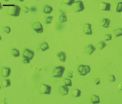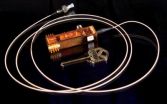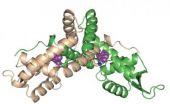(Press-News.org) Memphis, Tenn. – Studies at Le Bonheur Children's Hospital in Memphis, Tenn., are advancing our understanding of how viruses, including RSV, replicate in humans, mutate to avoid the immune response and can be effectively treated.
John DeVincenzo, MD, medical director of Molecular Diagnostics and Virology Laboratories at Le Bonheur, and professor of Pediatrics and Microbiology, Immunology, and Molecular Biology at The University of Tennessee Health Science Center, has recently published three papers on this topic. DeVincenzo's lab is one of only two of its kind in the United States. His work has focused on respiratory syncytial virus (RSV), the most common cause of infant hospitalization, and his findings are leading the way towards the development of antiviral treatment strategies against the disease.
Summaries of the studies' findings include:
Complete viral RNA genome sequencing of ultra-low copy samples by sequence-independent amplification.
Nucleic Acids Research, 2012
Viruses change and mutate at rapid rates in virtually random fashion. These high mutation rates of viruses always occur while they replicate within their human hosts. Detecting these changes has been difficult, because mutations that do not help the virus survive and replicate are overwhelmed by mutations that do help. Therefore, it is necessary to be able to detect minute populations of viruses that have mutated and to differentiate these small subpopulations from the majority populations of these viruses. This study outlines new advanced methods and techniques to detect minute sub-populations of viruses within clinical samples obtained from humans. These new techniques can open up areas of research in these viruses and how they mutate to avoid detection and control by our immune systems. Researchers capture 96 to 100 percent of the viral protein-coding region of HIV, respiratory syncytial and West Nile viral samples from as few as 100 copies of viral RNA. Methods are scalable to large numbers of samples and capable of generating full or near full-length viral genomes from clone and clinical samples with low amounts of viral RNA, without prior sequence information and in the presence of substantial RNA contamination from the surrounding human cells.
Assessing modeled CO2 retention and rebreathing of a facemask designed for efficient delivery of aerosols to infants.
International Scholarly Research Network, 2012
New medicines for infant lung diseases, such as RSV, might require deposition of these medicines directly into the lung by infants breathing an aerosol. However, efficient masks that allow the safe delivery of these aerosols without causing the infants to re-breathe their own exhaled CO2 have not previously been developed. The researchers developed a new infant aerosol delivery mask. They then evaluated the mask using computational fluid dynamic models to see if it would both efficiently deliver aerosols and whether there was retention of exhaled CO2. Because RSV (respiratory syncytial virus) primarily is an infant disease, this device could be used for delivery of aerosol treatments of RSV in infants and children.
The promise and progress of RNA interference-based antiviral therapy for respiratory viruses.
Antiviral Therapy, 2012
In this invited review, DeVincenzo discusses the science behind RNA interference (RNAi) and the potential practical issues in applying this novel treatment technology against various respiratory viral diseases. DeVincenzo was the first to demonstrate that RNAi-based therapies could work in humans. One of his recent studies showed that RSV-infected lung transplant patients treated with the novel RNAi therapy improved long term lung function significantly better than did those treated with placebo, even when the patients were analyzed as long as six months later. This marks the first effective treatment of RSV in this vulnerable immune-suppressed population. Ongoing research directed by DeVincenzo is now moving experimental RSV therapies into children.
###
About Le Bonheur Children's Hospital
Le Bonheur Children's Hospital in Memphis, Tenn., treats more than 250,000 children each year in a 255-bed hospital that features state-of-the-art technology and family-friendly resources. Nationally recognized, Le Bonheur is ranked by U.S. News & World Report as a "Best Children's Hospital." Serving as a primary teaching affiliate for the University Tennessee Health Science Center, the hospital trains more pediatricians than any other hospital in the state. For more information, please call (901) 287-6030 or visit lebonheur.org. Follow us on Twitter at twitter.com/lebonheurchild or like us at Facebook at facebook.com/lebonheurchildrens.
About the University of Tennessee Health Science Center
As the flagship statewide academic health system, the University of Tennessee Health Science Center is focused on a four-tier mission of education, research, clinical care and public service, all in support of a single goal: to improve the health of Tennesseans. Offering a broad range of postgraduate training opportunities, the main campus is located in Memphis and includes six colleges: Allied Health Sciences, Dentistry, Graduate Health Sciences, Medicine, Nursing and Pharmacy. UTHSC has additional College of Medicine and College of Pharmacy campuses in Knoxville, and a College of Medicine campus in Chattanooga. For more information, visit www.uthsc.edu.
Leading RSV researcher publishes work at Le Bonheur Children's
2013-02-15
ELSE PRESS RELEASES FROM THIS DATE:
Revealing the secrets of motility in archaea
2013-02-15
The protein structure of the motor that propels archaea has been characterized for the first time by a team of scientists from the U.S. Department of Energy's Lawrence Berkeley National Laboratory (Berkeley Lab) and Germany's Max Planck Institute (MPI) for Terrestrial Microbiology.
The motility structure of this third domain of life has long been called a flagellum, a whip-like filament that, like the well-studied bacterial flagellum, rotates like a propeller. But although the archaeal structure has a similar function, it is so profoundly different in structure, genetics, ...
APS applauds President Obama's support of R&D in SOTU
2013-02-15
WASHINGTON, D.C. – The American Physical Society (APS), the nation's largest organization of physicists, commends President Obama's exhortation in his State of the Union Speech that, "Now is the time to reach a level of research and development not seen since the height of the Space Race."
During the Space Race, the nation made huge investments in scientific research, which led to new discoveries, accelerated technological advancements and generated new innovations and businesses.
The President also noted that sequestration -- automatic spending cuts scheduled to occur ...
A dual look at photosystem II using the world's most powerful X-ray laser
2013-02-15
From providing living cells with energy, to nitrogen fixation, to the splitting of water molecules, the catalytic activities of metalloenzymes – proteins that contain a metal ion – are vital to life on Earth. A better understanding of the chemistry behind these catalytic activities could pave the way for exciting new technologies, most prominently artificial photosynthesis systems that would provide clean, green and renewable energy. Now, researchers with the U.S. Department of Energy (DOE)'s Lawrence Berkeley National Laboratory (Berkeley Lab) and the SLAC National Accelerator ...
Noncoding RNAs offer huge therapeutic and diagnostic potential
2013-02-15
New Rochelle, NY, February 14, 2013—As scientists continue to unravel the complexity of the human genome and to uncover vital elements that play a role in both normal physiology and disease, one particular class of elements called noncoding RNAs is gaining a lot of attention. Guest Editor Tom Cech, PhD and Executive Editor Fintan Steele, PhD explore the enormous potential value of this rapidly advancing research area in their Editorial " The (Noncoding) RNA World." The authors introduce a special research section on noncoding RNAs published in the current issue of Nucleic ...
Building healthy bones takes guts
2013-02-15
EAST LANSING, Mich. — In what could be an early step toward new treatments for people with osteoporosis, scientists at Michigan State University report that a natural probiotic supplement can help male mice produce healthier bones.
Interestingly, the same can't be said for female mice, the researchers report in the Journal of Cellular Physiology.
"We know that inflammation in the gut can cause bone loss, though it's unclear exactly why," said lead author Laura McCabe, a professor in MSU's departments of Physiology and Radiology. "The neat thing we found is that a probiotic ...
New methodology to predict pandemics
2013-02-15
NEW YORK – February 13, 2013 – EcoHealth Alliance, the nonprofit organization that focuses on local conservation and global health issues, announced new research focused on the rapid identification of disease outbreaks in the peer reviewed publication, Journal of the Royal Society Interface. The article, authored by leading scientists in the fields of emerging disease ecology, biomathematics, computational biology and bioinformatics, shows how network theory can be used to identify outbreaks of unidentified diseases. The strategy builds on the wealth of online surveillance ...
Quantum cryptography put to work for electric grid security
2013-02-15
LOS ALAMOS, N.M., Feb. 14, 2013—A Los Alamos National Laboratory quantum cryptography (QC) team has successfully completed the first-ever demonstration of securing control data for electric grids using quantum cryptography.
The demonstration was performed in the electric grid test bed that is part of the Trustworthy Cyber Infrastructure for the Power Grid (TCIPG) project at the University of Illinois Urbana-Champaign (UIUC) that was set up under the Department of Energy's Cyber Security for Energy Delivery Systems program in the Office of Electricity Delivery and Energy ...
A microbial biorefinery provides new insight into how bacteria regulate genes
2013-02-15
PROVIDENCE, R.I. [Brown University] — Microorganisms that can break down plant biomass into the precursors of biodiesel or other commodity chemicals might one day be used to produce alternatives to petroleum. But the potential of this "biorefinery" technology is limited by the fact that most microorganisms cannot break down lignin, a highly stable polymer that makes up as much as a third of plant biomass.
Streptomyces bacteria are among few microorganisms known to degrade and consume lignin. Now a group of researchers at Brown University has unlocked the genetic and molecular ...
NASA's Fermi proves supernova remnants produce cosmic rays
2013-02-15
A new study using observations from NASA's Fermi Gamma-ray Space Telescope reveals the first clear-cut evidence the expanding debris of exploded stars produces some of the fastest-moving matter in the universe. This discovery is a major step toward understanding the origin of cosmic rays, one of Fermi's primary mission goals.
"Scientists have been trying to find the sources of high-energy cosmic rays since their discovery a century ago," said Elizabeth Hays, a member of the research team and Fermi deputy project scientist at NASA's Goddard Space Flight Center in Greenbelt, ...
Researchers discover breakthrough in ovarian cancer
2013-02-15
(Phoenix, AZ Feb. 14, 2014) -- Researchers at The University of Arizona Cancer Center at St. Joseph's Hospital and Medical Center in Phoenix have discovered that many women with low-grade serous carcinoma of the ovary or peritoneum have seen their tumors stabilize or shrink after taking a regular dose of the compound selumetinib.
The findings, published in the Feb. 14 edition of The Lancet Oncology, show that selumetinib targets a mutation in the MAPK pathway for patients with low-grade serous carcinoma, allowing for treatment on previously chemoresistant tumors.
"This ...





